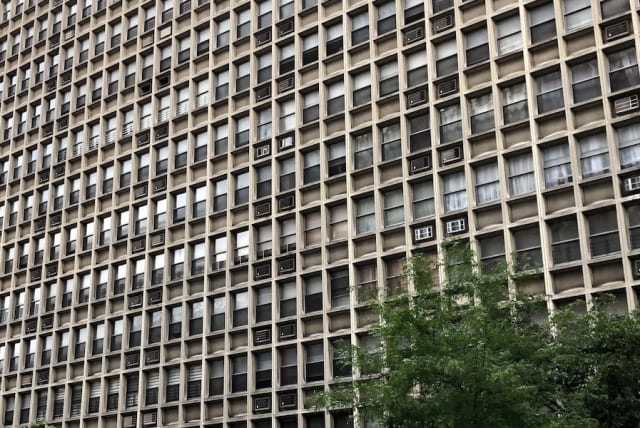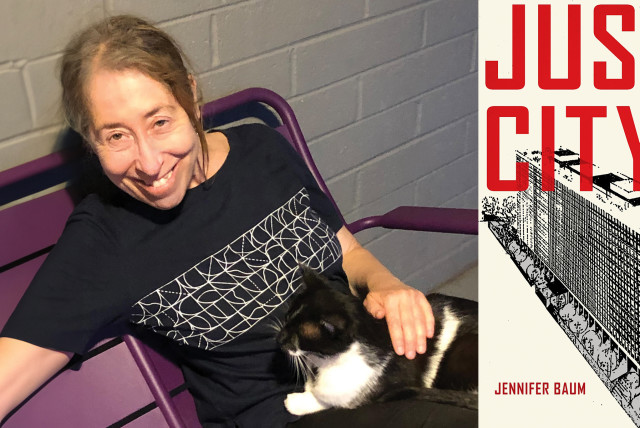'Housing was once a human right' for Jews growing up in New York City

As housing prices rise and the personalities of neighborhoods disappear, a return to affordable, safe, communal life in an integrated community is essential.
When Jennifer Baum’s parents bought their three-bedroom, postwar apartment on the Upper West Side in 1967, they paid $3,800 — a bargain even at the time, when the neighborhood was still gritty and New York on the cusp of steep decline.
For a middle-class Jewish couple committed to living in the city where they grew up, the 14th-floor apartment at RNA House, a 212-unit concrete slab on West 96th Street, was a dream come true. Their two daughters could grow up in a diverse neighborhood, a block and a half from Central Park and a walk or subway ride from all the city had to offer.
It was a dream made possible by a state and city program subsidizing middle-income rentals and co-ops across New York from the 1950s until the fiscal crisis of the late ’70s. When the middle class fled to the suburbs, the Mitchell-Lama Housing Program (named for the politicians who championed it in 1955) was a boon for people too well-off to qualify for public housing and too poor to afford market-rate homes.
“It celebrated the idea of the common good,” Baum told me in an interview. “It was a very comprehensive, unusual experiment that enabled the Upper West Side to retain a feeling of diversity — economically and culturally — at a time when government really believed in trying to make the city a livable place for all.”
Baum writes about growing up in a Mitchell-Lama building in “Just City: Growing Up on the Upper West Side When Housing Was a Human Right.” A memoir for which Baum took a deep dive into the history of city housing, the new book arrives as cities such as New York face an affordable housing crisis — and just as New York state legislators are calling for “Mitchell-Lama 2.0.” The state Senate’s “One House” budget proposal includes the creation of a housing corporation to finance a mix of new affordable rentals and co-ops on state-owned land; the Assembly has also earmarked $500 million for a plan to finance limited-equity co-ops in the Mitchell-Lama mold. (Negotiations over the state budget are expected to extend to Thursday).
The book is also a nostalgic look at a vanishing Jewish New York. While the relatively diverse Upper West Side still has a large and largely liberal Jewish community, the gaps between haves and have-nots are only growing wider, and the housing stock is out of reach to all but the affluent.
Baum, 61, a filmmaker and writer now living in Brooklyn, remembers a funkier, less gentrified UWS, known for its Cuban-Chinese, Kosher, Middle Eastern, Italian, Greek, and Irish restaurants, Jewish refugees who’d escaped Hitler and pogroms, stoned junkies, muggings, the deinstitutionalized mentally ill living in single-room occupancy hotels (SROs), art film aficionados at the Thalia, Cuban musicians, artists, actors, crooks, prostitutes, political activists, grape boycotters, alcoholics, eccentrics, graffiti, sidewalks carpeted with broken glass, dog shit, and litter.
If that doesn’t sound appealing, Baum also remembers playing with kids from a variety of backgrounds — middle-class and poor, Black and white, Jewish and Puerto Rican. Wary of appearing Pollyannaish, when she began researching the book, she reached out to members of the “Growing Up on the Old Upper West Side” Facebook group. Sure enough, they, too, shared memories of a neighborhood where people got along across racial and class lines and, especially in the Mitchell-Lama houses, shared a sense of common purpose and cooperation that turned the city into a sort of village.
“I was living in Vancouver when a friend wanted me to go to some kind of racism workshop, and I said to her, ‘You know, my whole life has been a racism workshop,’” Baum recalled. “I feel very fortunate to have grown up just the way I did, and I credit that to my parents.”
Her mother Judy, who would later become an advocate for New York City’s public schools, was from Brooklyn; her father Charles was from the Bronx. Her paternal grandmother was born on the Lower East Side and worked, like so many Jews at the time, in a garment factory. “She adored Eleanor Roosevelt,” recalled Baum, who relates how the president’s wife gave a speech in 1935 when the New York City Housing Authority built the first federally funded public housing project. “She spoke about how important it was for the government to take responsibility for people.”
Her parents weren’t radicals, but progressives who came of age in the 1950s and believed “in the dream of equality through architecture,” Baum writes. As “cooperators” at RNA House, she explains, they owned a share of the co-op, which they had to sell back for the same amount if they left. Family members could not inherit the property unless they lived there full time; when the cooperators sold or died, a new family would take over, plucked from a long waiting list. RNA House also included apartments with reduced maintenance charges for neighbors displaced by development.
The goal for guaranteed and safe communities
“The idea was not to make a profit but to live an affordable, safe, communal life in an integrated community where everybody had a stake,” writes Baum.
Baum’s father, a professor turned mechanical engineer, died when she was 10 — shockingly, during a visit to her elementary school. Judy Baum would live at #14E until her death, at 77, in 2013. Her daughters’ grief was compounded by the reality of having to relinquish the apartment, which Baum describes in a chapter that plumbs the dilemmas of the subsidized co-op model.
“It was devastating and I still feel devastated by it,” Baum told me. “It wasn’t so much that I wanted to hold on to it because I wanted to turn a profit and make $3 million. It was that this apartment meant so much to me emotionally. I knew that it should remain public because it’s only fair. And I wanted to hold on to it because it had such emotional value to it. I still have a hard time walking by RNA.”
Writing about recent efforts to privatize RNA House, Baum describes how these tensions are magnified not just by greed but by rational human calculations. Residents seeing apartments in privatized buildings selling for seven figures are understandably chagrined to give up their own apartments in return for “equity accrued minus repairs” — in Baum’s case, $34,000 in 2014, when a typical three-bedroom in Manhattan was selling for $1.5 million. Black residents whose families had been subjected to redlining understandably resent having to forgo a profit from yet another property in which they have invested years of their lives.
Baum’s old friend Mondello Browner, who grew up in a massive Mitchell-Lama development in Central Harlem and now analyzes housing data for the city, described his own ambivalence to her:
I very much want Mitchell-Lamas to remain viable choices for middle-class residents. I do realize that many long-term residents would like to be rewarded for their patience and longevity with the ability to sell out, or I guess to get home equity loans, based upon market-rate values. But this ability is at the expense of the current crop of financially struggling, aspiring folks who have one less set of economic ladders to use.
So far, cooperators at RNA House have not voted to privatize, although, between 1989 and 2017, “nearly 20,000 of the city-supervised co-ops and rentals in Mitchell-Lama buildings have left the program,” according to the city.
Although Baum writes about other ethnic groups and the racial inequities built into some city housing programs, hers is also a strikingly Jewish story. Jews like her parents — “pink diaper” progressives, as one of her interviewees described them — were particularly drawn to Mitchell-Lama co-ops, while others chased the American Dream to Long Island and Westchester County.
It’s a clash of values — political and economic — that Baum captures in a reference to “Marjorie Morningstar,” Herman Wouk’s mid-century novel about a striving Jewish family.
In the novel, Marjorie’s Jewish parents move to a ritzy building on Central Park West. “By moving to the El Dorado,” writes Wouk, “her parents had done much, Marjorie believed, to make up for their immigrant origin.” For Baum, these were the “opposite goals of my progressive parents, who strove for social justice, not social success.”
Jews are also overrepresented among the powerbrokers who shaped housing in New York in the 20th century. Baum writes of the Jewish-led unions that built cooperative housing and middle-income rentals. Her heroes include liberals like New York Mayor Fiorello La Guardia and Manhattan Borough President Ruth Messinger; her villains include master planner Robert Moses and Mayor Mike Bloomberg. Baum blames Bloomberg and another former mayor, Rudy Giuliani, for putting the interests of private developers and the rich ahead of the “common good.”
I asked Baum if she empathized with those who are grateful to Giuliani and Bloomberg for making the city safer, cleaner and more financially solvent, even if gentrification came at the expense of a more vibrant street life and the kinds of mom-and-pop stores that she remembers so fondly.
“I feel it shouldn’t be a tradeoff. I don’t feel like it should be cleaner and more livable for the rich people. It’s just not fair,” she said. “We should be able to have clean livability for everybody. I used to think that the Mitchell-Lamas in the neighborhood paved the way for inevitable gentrification. It didn’t have to be that way: The government could have continued to build affordable housing even as the neighborhood became safer."
“It shouldn’t be an either/or situation.”
The views and opinions expressed in this article are those of the author and do not necessarily reflect the views of JTA or its parent company, 70 Faces Media.
Jerusalem Post Store
`; document.getElementById("linkPremium").innerHTML = cont; var divWithLink = document.getElementById("premium-link"); if (divWithLink !== null && divWithLink !== 'undefined') { divWithLink.style.border = "solid 1px #cb0f3e"; divWithLink.style.textAlign = "center"; divWithLink.style.marginBottom = "15px"; divWithLink.style.marginTop = "15px"; divWithLink.style.width = "100%"; divWithLink.style.backgroundColor = "#122952"; divWithLink.style.color = "#ffffff"; divWithLink.style.lineHeight = "1.5"; } } (function (v, i) { });

